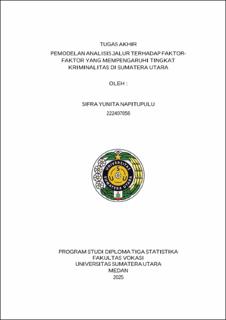Pemodelan Analisis Jalur terhadap Faktor-Faktor yang Mempengaruhi Tingkat Kriminalitas di Sumatera Utara
Path Analysis Modeling of Factors Influencing Crime Levels in North Sumatera
Abstract
Crime is a complex social problem and an important indicator in assessing the
security stability of a region. This study aims to analyze the direct and indirect
influence of several social and economic factors on crime rates in North Sumatra
Province using path analysis. Secondary data was obtained from the Central
Statistics Agency and the North Sumatra Regional Police in 2023, covering 33
regencies/cities. The independent variables in this study include the poverty rate
(average 10.32%), open unemployment rate (average 6.28%), education level
(average years of schooling 8.1 years), and population density (average 1,207
people/km²), while the dependent variable is the crime rate (average 145 cases per
100,000 population). The analysis shows that the poverty rate has the most
significant direct effect on crime, with a path coefficient of 0.53. The unemployment
rate has a direct effect of 0.41, while education has an indirect effect on crime
through unemployment, with a total path coefficient of 0.27. The coefficient of
determination (R²) of the model is 0.76, meaning that 76% of the variation in the
crime rate can be explained by these variables. These findings suggest that crime
prevention strategies in North Sumatra need to focus on reducing poverty and
unemployment and improving the quality of education.
Collections
- Diploma Papers [191]

